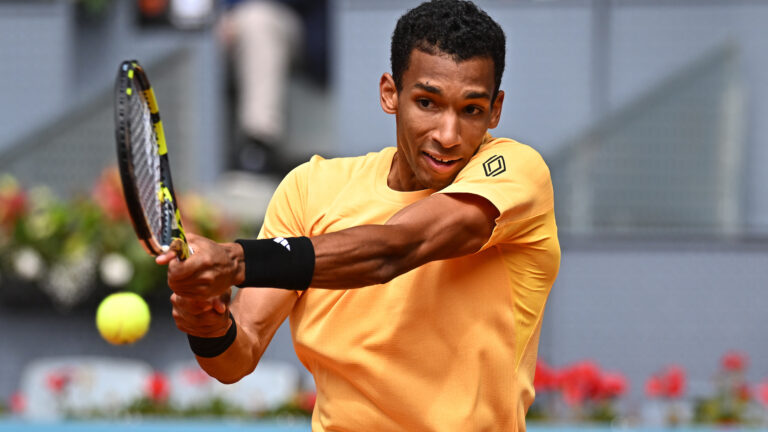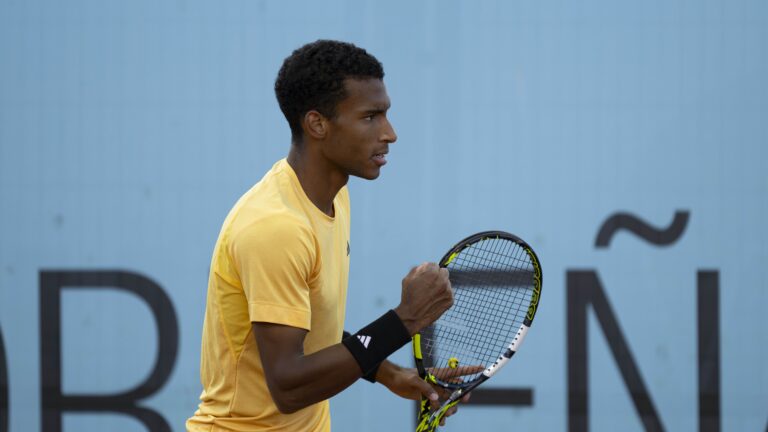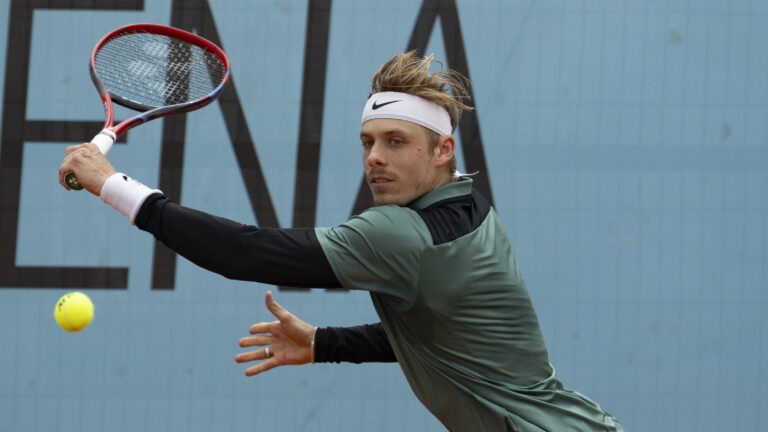TEBBUTT: MILOS AND HIS POSSE

Art Seitz
After two days off, Milos Raonic gets back into action on Thursday with a late afternoon match against Peter Gojowczyk of Germany.
Raonic, above in a fun picture with his team – trainer Dalibor Sirola (Croatia), coach Riccardo Piatti (Italy), coach Ivan Ljubicic (Croatia) and physio Claudio Zimiglia (Italy) – has been busy honing his game since his opening-round victory over Taro Daniel on Monday.
Ljubicic, a former world No. 3 (2006), has been Raonic’s principal sparring partner – hitting with him for an hour and a half on Tuesday and an hour on Wednesday.
The US Open is the only Grand Slam that extends the first round over three days, meaning players sometimes get two complete days off between matches. That’s partly to spread the riches around but more to allow the CBS network to jig and rig the schedule for the Labour Day weekend when it takes over most coverage from ESPN. By waiting until late Tuesday, CBS is able to select which halves of the draw will play and when. It likes to get Saturday and Monday exposure out of the most attractive names and this year has decided that the top half featuring Novak Djokovic, Andy Murray, Stan Wawrinka, Jo-Wilfried Tsonga, John Isner and Raonic is more appealing to its audience than the bottom half with Roger Federer, Grigor Dimitrov, David Ferrer and Tomas Berdych as its biggest drawing cards.
So, Raonic is now on the Thursday, Saturday, Monday cycle leading to a potential Wednesday quarter-final vs. No. 3 seed Wawrinka.
Everything could change next year when the US Open will be covered start to finish by ESPN when it takes over after six decades of CBS as the main broadcaster.

Anita Aguilar/TENNIS.com
Regarding Thursday’s 5 p.m. match in Louis Armstrong Stadium, coach Ljubicic has been counselling Raonic not to focus on his 6-4, 6-4 loss to Gojowczyk in Halle on grass right after the French Open. It should not be about revenge – more about redeeming himself and his poor play in a better situation (at Flushing Meadows) and on a surface that should favour him.
For the fashionistas, Raonic will be wearing the shorter version of his shorts, with a shorter cut, than he wore in Washington, Toronto and Cincinnati. He requested the shortening because of the potential heat in New York. That would have worked more on Wednesday when the thermometer reached almost 32 degrees. It’s only supposed to get to a high of 28 on Thursday.
DANCEVIC DOWNER IN FIVE SETS

It was close to an artistic tour de force – a five-set, high quality match over three hours and 32 minutes between two evenly-matched players – but the final score came out 7-6(6), 3-6, 6-2, 4-6, 7-6(2) in favour of Joao Sousa of Portugal in his opening round against Frank Dancevic.
It was the 29-year-old Dancevic’s fifth US Open main draw and he was trying to win only his second match after a victory over Robin Haase 12 months ago.
The first significant psychological tilt in the match went to the No. 38-ranked Sousa late in the first set when he saved five set points and took the tiebreak by winning seven points in a row after trailing 6-1.
“I tried to forget it,” Dancevic said later. “I feel I got really unlucky. I missed a few shots by a little bit and missed a serve by a millimetre.”

Dancevic did a lot of things well over the course of the match – and made a valiant rally from 5-2 down to 5-all in the final set. In the end, his cliché about it coming down to a few points was accurate. Specifically, Sousa led the fifth-set tiebreak 3-0 (two mini-breaks) before Dancevic got back on serve to 3-2. The next point was a dagger – Dancevic drove an approach shot deep but Sousa stabbed a backhand lob that went up and over Dancevic and wound up being unplayable. Momentum had made its final turn – in the direction of the 25-year-old Portuguese.
Dancevic related how he has been using a new Wilson racquet after seven or eight years with his previous BLX model. It’s a variation on the 97 sq. in. new Roger Federer Wilson frame and he’s excited about what it does for his game – helps his second serve, helps his returns, helps his depth from the baseline and helps make his volleys crisper. The only problem for him was that he had only been using the racquet for a few days and only had two of them. That meant he wasn’t sure about how long the strings would hold and thought that loose strings might have contributed to his service break in the sixth game of the final set. He sent each frame out for one re-string during the match.
Even though he conceded the loss was “heart-breaking,” he was able to say, “I felt really good physically. There were a lot of long rallies, three-dimensional, all over the court and using all the shots.
“It would have been nice to win but I’ll keep my head high and keep going.”

During the third set, an usher (above in yellow) went over and spoke to David Morris (tan-coloured hat), a Dancevic supporter from B.C., telling him he would have to be less vocal in his support because Sousa had complained to the umpire. Morris had done nothing at all offensive and the official warning was completely unjustified.
“You pay money to come here,” Morris said. “You should be able to say something – I wasn’t saying anything bad.”
The extent of his encouragement were a few “c’mon Frank, you can do it” and “all the way back Frank.” Anything he said was done properly between the points. “They should come to a hockey game,” Morris joked.

About Davis Cup versus Colombia from September 12-14 in Halifax, Dancevic said, “I’m available. I’ll be there.”
At the very end of his media conference, he was asked one of those hypothetical questions about which era of tennis he would like to have played in – which led to a question about what he might be doing in ten years. That brought gales of laughter from the affable Frankie D. and he said, “I’ll probably be a fishing captain. If you ever want to come fishing, call me “Skipper Frank” and I’ll take you out and catch some salmon.”
DABROWSKI WINS IN DOUBLES

Gabriela Dabrowski and her partner Alicja Rosolska caused a surprise in the women’s doubles on Wednesday when they upset No. 10-seeded Ashleigh Barty and Casey Dellacqua of Australia 6-2, 6-3.
A year ago, Barty, 18, and Dellacqua, 29, reached the finals of the Australian Open, Wimbledon and US Open. In 2014, they did not make the semifinals at any Grand Slam and have won just one title – Strasbourg before the French Open.
“I thought it was execution,” Dabrowski said about the key to her side’s victory. “Any plans or strategies that we had in mind – I knew that if we were able to execute them, we’d have a good shot at winning. I’d never seen them (Barty and Dellacqua) play before but I watched a little bit on YouTube and got a little bit of advice from other girls. They said that they’re a good doubles team but they can falter at times too, if you put pressure on them. Especially if both players are at the net, you can expect a lot of lobs. But then they weren’t even lobbing that much so they couldn’t have been comfortable with what we were doing.”

Dabrowski, 22, from Ottawa, and Rosolska, a 28-year-old from Poland, first played together in Linz, Austria, last October, and made it to the final.
Currently, Dabrowski is No. 69 in the WTA individual doubles rankings while Rosolska is No. 66.
“We played together this year for about two and a half months in Europe and honestly I thought we were going to do a lot better because when we practice together we actually worked together really well,” Dabrowski said. “And we’re very supportive. This was one of our better matches – not just because we won, but because of everything that we did to win. Everything was working.”
In the second round, she and Rosolska will play the unseeded pair of Misaki Doi of Japan and Elina Svitolina of Ukraine.
In another opening-round doubles match, Sharon Fichman and her South African partner Chanelle Scheepers were beaten 6-4, 7-6(3) by No. 5 seeds Katarina Srebotnik and Kveta Peschke.

In mixed doubles (above), Daniel Nestor and Kristina Mladenovic, seeded fourth, were upset in the first round by Russ Hutchins of Britain and Chan Yung-Jan of Taipei.
NOTE: Vasek Pospisil and Jack Sock are slated to play their US Open first round doubles match against Henri Kontinen and Jarkko Nieminen of Finland on Court 6 at 11 a.m. on Thursday.
POLANSKY: CLOSE BUT NO PULLOUTS

Even though Peter Polansky (above with longtime coach Dean Coburn) lost in the final round of qualifying last Friday, he had reasonable hopes he would make the main US Open draw as a lucky loser.
“They took the four highest-ranked players and drew them,” he explained about he and his fellow final round of qualifying losers. “I was the second-highest ranked and I got picked No. 1. And the No. 1 highest-ranked got three…so it’s kind of just the luck of the draw.”
About his routine, as he waited on the first three days of this year’s US Open, he said around midday on Wednesday, “I’ve come here at around 9:30 every morning and I’ve been leaving at 8 p.m. every night hoping that someone doesn’t show or someone gets injured, or anything like that. Today’s the last day, they started with 16 first-round men’s matches. There’s a slim chance but I’ll stay here and wait.
“It’s tough, because you don’t want to practice too much in case I get thrown into a match. It’s best-of-five sets so you can’t really practice two hours in the morning if you’re going to be playing five sets. I’ve been doing a good warm-up every morning – about 40 minutes. Then, towards the end of the day, if nothing’s happening, I’ve been doing a workout as well, just keeping sharp.”
Usually there’s shoptalk and hearsay about players who might not post for the tournament. “There haven’t been that many rumours at all this year,” Polansky said. “Everyone I’ve asked they haven’t heard anything, even the physios they don’t know anything. Everyone seems to be pretty healthy other than (Albert) Montanes who retired (6-2, 2-0 down) and hasn’t really played too much this year. Other than him, everyone’s here and everyone’s healthy.
“It’s a bit unlucky if I don’t get in this time because for sure every Slam there’s at least one (withdrawal). At Wimbledon, there were five or six this year. I’d be extremely unlucky not to get in, but that’s the way it goes.
“In the end, I did lose in the last round of the qualies, so I didn’t earn my way into the tournament, but getting in definitely would have been a good bonus – experience-wise and I’ve been playing well, so I feel like I could beat a bunch of players…but that’s just the way it goes.”
Polansky did not get in and now plans to play two Challenger events in Turkey and will not be part of the Canadian Davis Cup team that faces Colombia in a World Group Play-off round in Halifax from September 12-14.


